IKEA Business Strategy Report: PESTLE, SWOT, and Porter's Five Forces
VerifiedAdded on 2023/01/19
|18
|5515
|62
Report
AI Summary
This report provides a comprehensive analysis of IKEA's business strategy, examining its response to the macro-environment, assessing its internal capabilities, and evaluating its market position. The report begins with an introduction to IKEA's business strategy, followed by an analysis of the macro-environmental factors using PESTLE analysis, including political, economic, social, technological, legal, and environmental factors. It then assesses IKEA's internal environment and capabilities using SWOT and VRIO analyses, identifying strengths, weaknesses, opportunities, and threats, as well as valuable, rare, inimitable, and organizationally supported resources. The report also applies Porter's Five Forces model to evaluate the competitive landscape of the furniture market. Finally, the report discusses strategic directions available to IKEA, applying relevant theories, concepts, and models to understand and interpret its strategic options. The conclusion summarizes the key findings and recommendations for IKEA's future strategic planning.
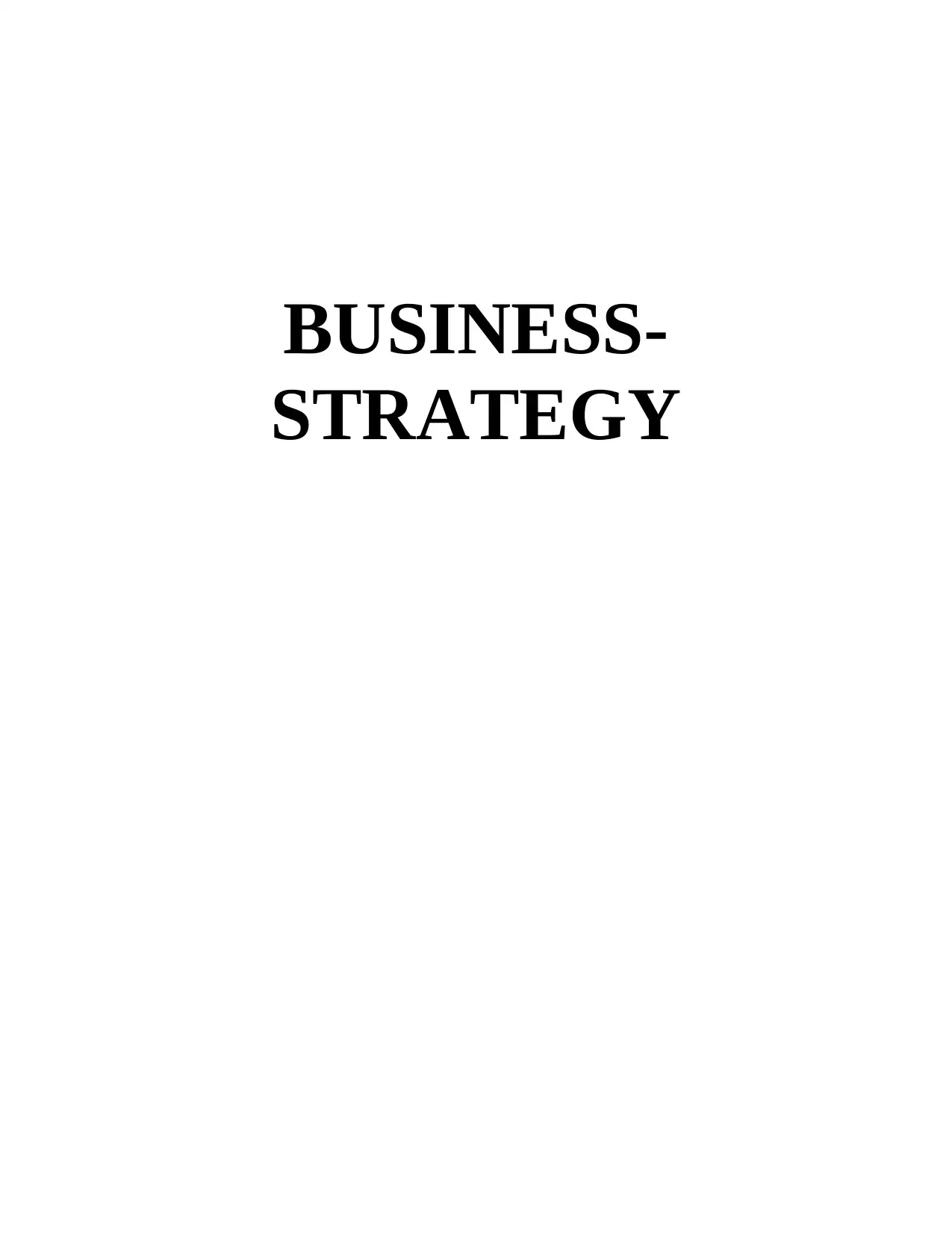
BUSINESS-
STRATEGY
STRATEGY
Paraphrase This Document
Need a fresh take? Get an instant paraphrase of this document with our AI Paraphraser

Table of Contents
INTRODUCTION...........................................................................................................................1
TASK 1............................................................................................................................................1
Impact and influence of macro environment on organisation and its business strategies......1
TASK 2............................................................................................................................................6
Assessment of internal environment and capabilities............................................................6
TASK 3............................................................................................................................................8
Evaluation of a given market by applying Porter's Five Force Model..................................8
TASK 4..........................................................................................................................................12
Applying of theories, concepts, models to understand and interpret strategic directions
available to a company.........................................................................................................12
CONCLUSION..............................................................................................................................15
REFERENCES..............................................................................................................................16
INTRODUCTION...........................................................................................................................1
TASK 1............................................................................................................................................1
Impact and influence of macro environment on organisation and its business strategies......1
TASK 2............................................................................................................................................6
Assessment of internal environment and capabilities............................................................6
TASK 3............................................................................................................................................8
Evaluation of a given market by applying Porter's Five Force Model..................................8
TASK 4..........................................................................................................................................12
Applying of theories, concepts, models to understand and interpret strategic directions
available to a company.........................................................................................................12
CONCLUSION..............................................................................................................................15
REFERENCES..............................................................................................................................16
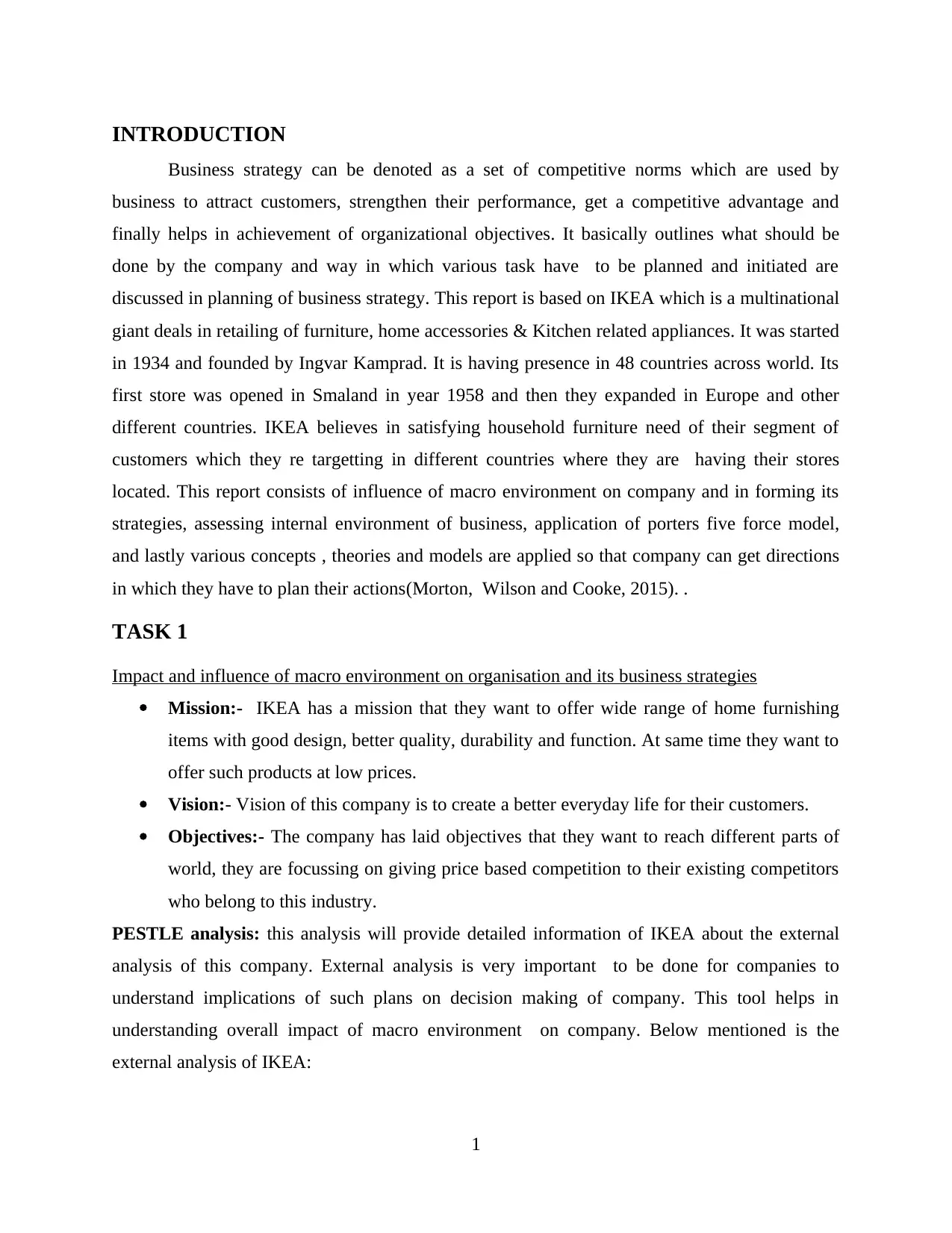
INTRODUCTION
Business strategy can be denoted as a set of competitive norms which are used by
business to attract customers, strengthen their performance, get a competitive advantage and
finally helps in achievement of organizational objectives. It basically outlines what should be
done by the company and way in which various task have to be planned and initiated are
discussed in planning of business strategy. This report is based on IKEA which is a multinational
giant deals in retailing of furniture, home accessories & Kitchen related appliances. It was started
in 1934 and founded by Ingvar Kamprad. It is having presence in 48 countries across world. Its
first store was opened in Smaland in year 1958 and then they expanded in Europe and other
different countries. IKEA believes in satisfying household furniture need of their segment of
customers which they re targetting in different countries where they are having their stores
located. This report consists of influence of macro environment on company and in forming its
strategies, assessing internal environment of business, application of porters five force model,
and lastly various concepts , theories and models are applied so that company can get directions
in which they have to plan their actions(Morton, Wilson and Cooke, 2015). .
TASK 1
Impact and influence of macro environment on organisation and its business strategies
Mission:- IKEA has a mission that they want to offer wide range of home furnishing
items with good design, better quality, durability and function. At same time they want to
offer such products at low prices.
Vision:- Vision of this company is to create a better everyday life for their customers.
Objectives:- The company has laid objectives that they want to reach different parts of
world, they are focussing on giving price based competition to their existing competitors
who belong to this industry.
PESTLE analysis: this analysis will provide detailed information of IKEA about the external
analysis of this company. External analysis is very important to be done for companies to
understand implications of such plans on decision making of company. This tool helps in
understanding overall impact of macro environment on company. Below mentioned is the
external analysis of IKEA:
1
Business strategy can be denoted as a set of competitive norms which are used by
business to attract customers, strengthen their performance, get a competitive advantage and
finally helps in achievement of organizational objectives. It basically outlines what should be
done by the company and way in which various task have to be planned and initiated are
discussed in planning of business strategy. This report is based on IKEA which is a multinational
giant deals in retailing of furniture, home accessories & Kitchen related appliances. It was started
in 1934 and founded by Ingvar Kamprad. It is having presence in 48 countries across world. Its
first store was opened in Smaland in year 1958 and then they expanded in Europe and other
different countries. IKEA believes in satisfying household furniture need of their segment of
customers which they re targetting in different countries where they are having their stores
located. This report consists of influence of macro environment on company and in forming its
strategies, assessing internal environment of business, application of porters five force model,
and lastly various concepts , theories and models are applied so that company can get directions
in which they have to plan their actions(Morton, Wilson and Cooke, 2015). .
TASK 1
Impact and influence of macro environment on organisation and its business strategies
Mission:- IKEA has a mission that they want to offer wide range of home furnishing
items with good design, better quality, durability and function. At same time they want to
offer such products at low prices.
Vision:- Vision of this company is to create a better everyday life for their customers.
Objectives:- The company has laid objectives that they want to reach different parts of
world, they are focussing on giving price based competition to their existing competitors
who belong to this industry.
PESTLE analysis: this analysis will provide detailed information of IKEA about the external
analysis of this company. External analysis is very important to be done for companies to
understand implications of such plans on decision making of company. This tool helps in
understanding overall impact of macro environment on company. Below mentioned is the
external analysis of IKEA:
1
⊘ This is a preview!⊘
Do you want full access?
Subscribe today to unlock all pages.

Trusted by 1+ million students worldwide
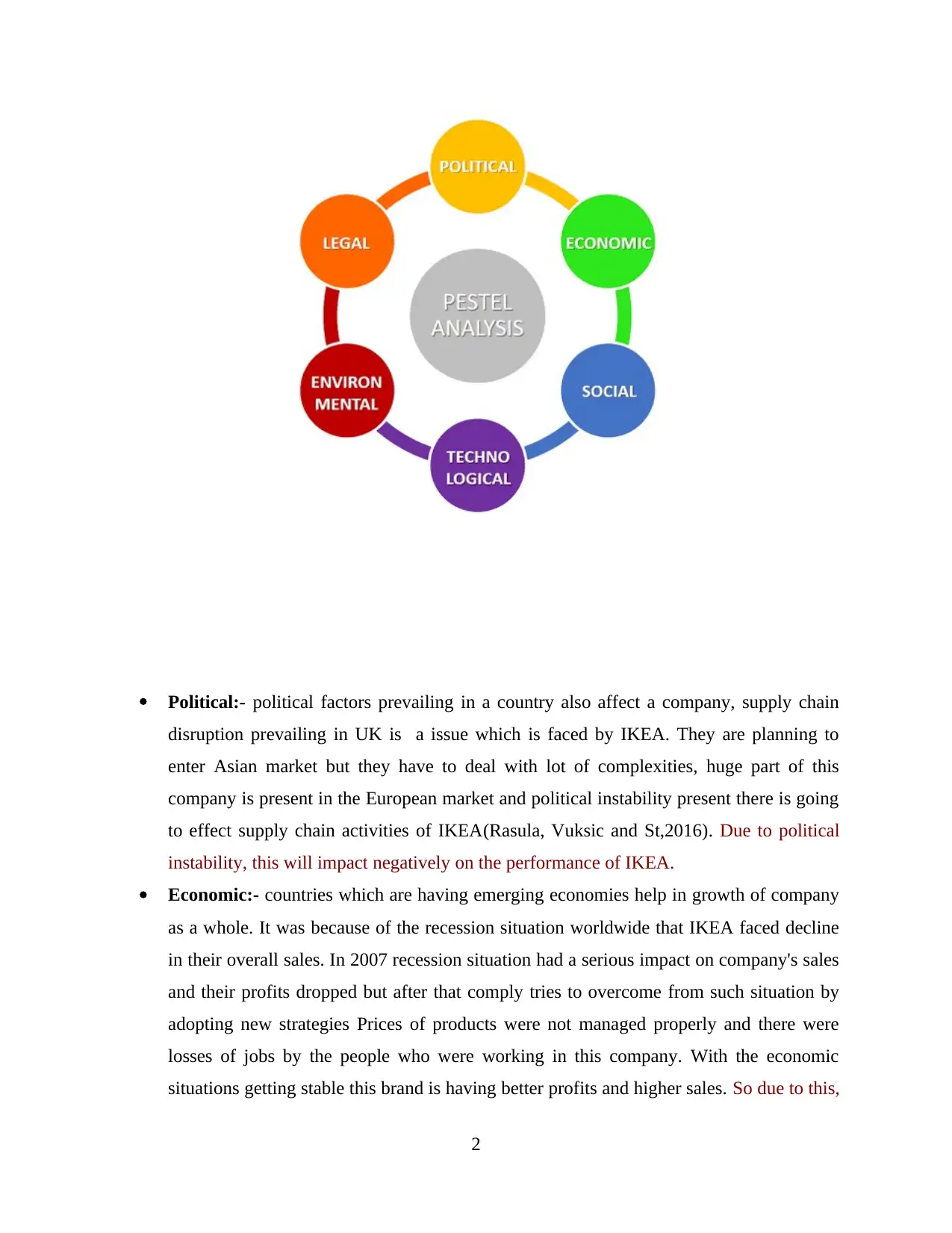
Political:- political factors prevailing in a country also affect a company, supply chain
disruption prevailing in UK is a issue which is faced by IKEA. They are planning to
enter Asian market but they have to deal with lot of complexities, huge part of this
company is present in the European market and political instability present there is going
to effect supply chain activities of IKEA(Rasula, Vuksic and St,2016). Due to political
instability, this will impact negatively on the performance of IKEA.
Economic:- countries which are having emerging economies help in growth of company
as a whole. It was because of the recession situation worldwide that IKEA faced decline
in their overall sales. In 2007 recession situation had a serious impact on company's sales
and their profits dropped but after that comply tries to overcome from such situation by
adopting new strategies Prices of products were not managed properly and there were
losses of jobs by the people who were working in this company. With the economic
situations getting stable this brand is having better profits and higher sales. So due to this,
2
disruption prevailing in UK is a issue which is faced by IKEA. They are planning to
enter Asian market but they have to deal with lot of complexities, huge part of this
company is present in the European market and political instability present there is going
to effect supply chain activities of IKEA(Rasula, Vuksic and St,2016). Due to political
instability, this will impact negatively on the performance of IKEA.
Economic:- countries which are having emerging economies help in growth of company
as a whole. It was because of the recession situation worldwide that IKEA faced decline
in their overall sales. In 2007 recession situation had a serious impact on company's sales
and their profits dropped but after that comply tries to overcome from such situation by
adopting new strategies Prices of products were not managed properly and there were
losses of jobs by the people who were working in this company. With the economic
situations getting stable this brand is having better profits and higher sales. So due to this,
2
Paraphrase This Document
Need a fresh take? Get an instant paraphrase of this document with our AI Paraphraser
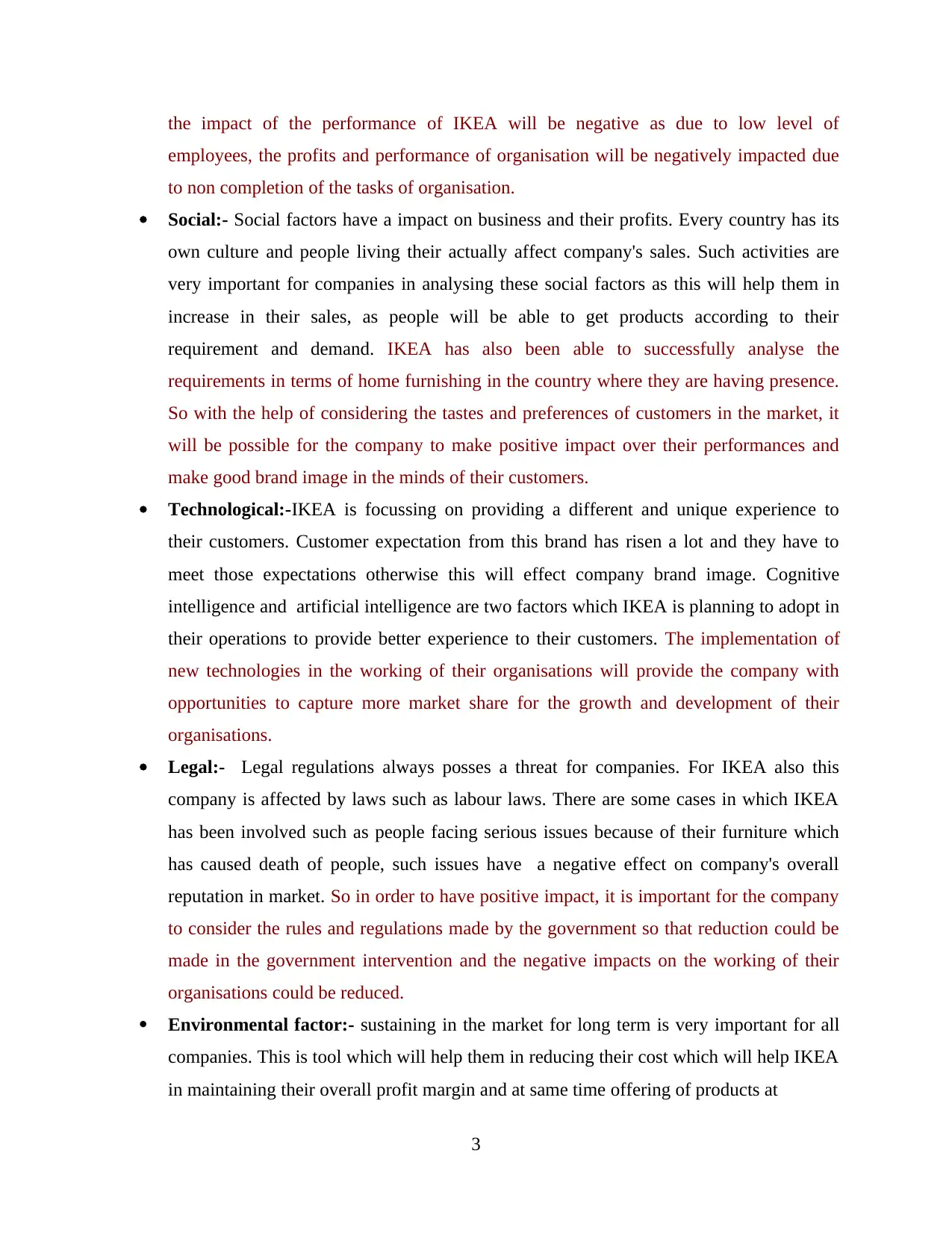
the impact of the performance of IKEA will be negative as due to low level of
employees, the profits and performance of organisation will be negatively impacted due
to non completion of the tasks of organisation.
Social:- Social factors have a impact on business and their profits. Every country has its
own culture and people living their actually affect company's sales. Such activities are
very important for companies in analysing these social factors as this will help them in
increase in their sales, as people will be able to get products according to their
requirement and demand. IKEA has also been able to successfully analyse the
requirements in terms of home furnishing in the country where they are having presence.
So with the help of considering the tastes and preferences of customers in the market, it
will be possible for the company to make positive impact over their performances and
make good brand image in the minds of their customers.
Technological:-IKEA is focussing on providing a different and unique experience to
their customers. Customer expectation from this brand has risen a lot and they have to
meet those expectations otherwise this will effect company brand image. Cognitive
intelligence and artificial intelligence are two factors which IKEA is planning to adopt in
their operations to provide better experience to their customers. The implementation of
new technologies in the working of their organisations will provide the company with
opportunities to capture more market share for the growth and development of their
organisations.
Legal:- Legal regulations always posses a threat for companies. For IKEA also this
company is affected by laws such as labour laws. There are some cases in which IKEA
has been involved such as people facing serious issues because of their furniture which
has caused death of people, such issues have a negative effect on company's overall
reputation in market. So in order to have positive impact, it is important for the company
to consider the rules and regulations made by the government so that reduction could be
made in the government intervention and the negative impacts on the working of their
organisations could be reduced.
Environmental factor:- sustaining in the market for long term is very important for all
companies. This is tool which will help them in reducing their cost which will help IKEA
in maintaining their overall profit margin and at same time offering of products at
3
employees, the profits and performance of organisation will be negatively impacted due
to non completion of the tasks of organisation.
Social:- Social factors have a impact on business and their profits. Every country has its
own culture and people living their actually affect company's sales. Such activities are
very important for companies in analysing these social factors as this will help them in
increase in their sales, as people will be able to get products according to their
requirement and demand. IKEA has also been able to successfully analyse the
requirements in terms of home furnishing in the country where they are having presence.
So with the help of considering the tastes and preferences of customers in the market, it
will be possible for the company to make positive impact over their performances and
make good brand image in the minds of their customers.
Technological:-IKEA is focussing on providing a different and unique experience to
their customers. Customer expectation from this brand has risen a lot and they have to
meet those expectations otherwise this will effect company brand image. Cognitive
intelligence and artificial intelligence are two factors which IKEA is planning to adopt in
their operations to provide better experience to their customers. The implementation of
new technologies in the working of their organisations will provide the company with
opportunities to capture more market share for the growth and development of their
organisations.
Legal:- Legal regulations always posses a threat for companies. For IKEA also this
company is affected by laws such as labour laws. There are some cases in which IKEA
has been involved such as people facing serious issues because of their furniture which
has caused death of people, such issues have a negative effect on company's overall
reputation in market. So in order to have positive impact, it is important for the company
to consider the rules and regulations made by the government so that reduction could be
made in the government intervention and the negative impacts on the working of their
organisations could be reduced.
Environmental factor:- sustaining in the market for long term is very important for all
companies. This is tool which will help them in reducing their cost which will help IKEA
in maintaining their overall profit margin and at same time offering of products at
3
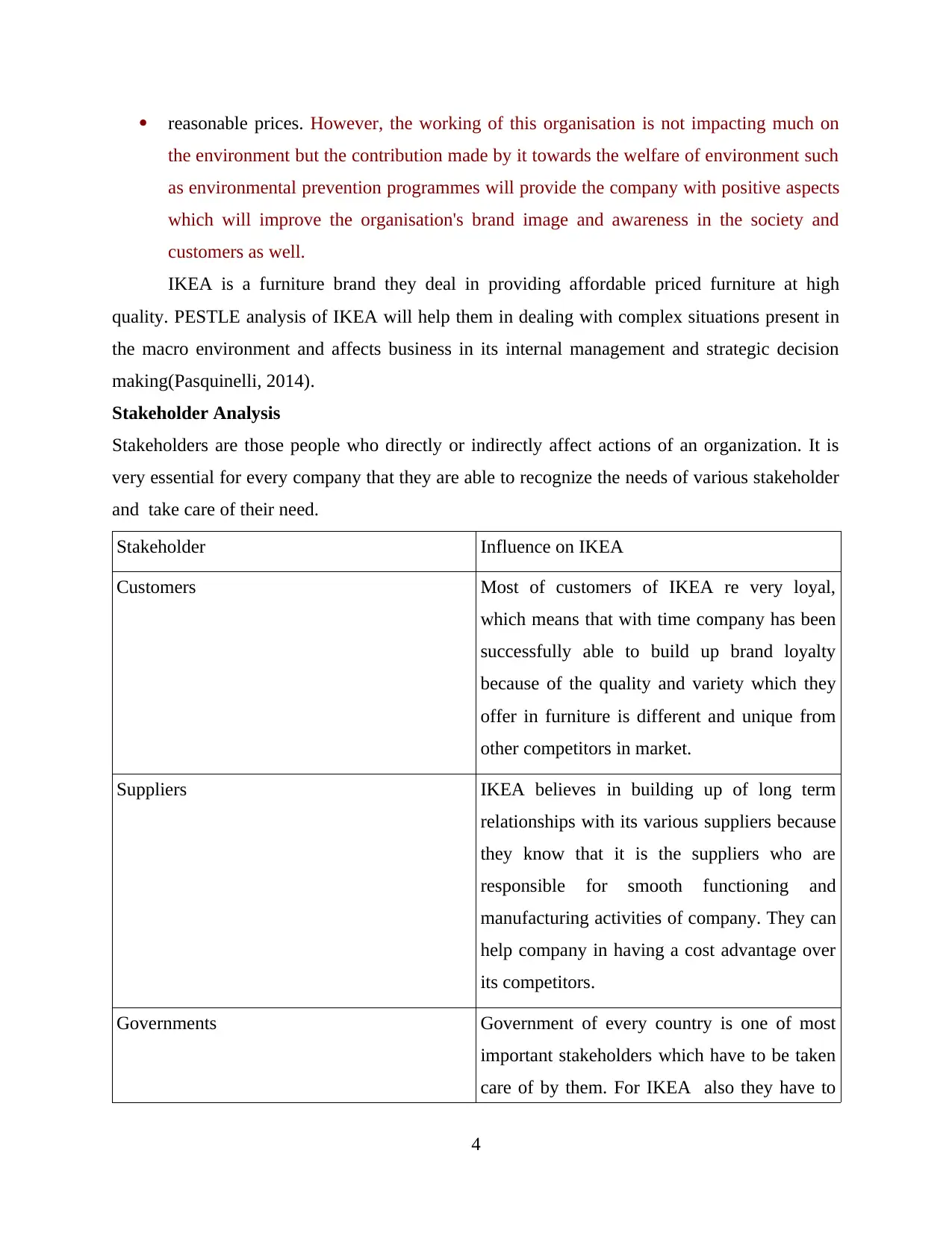
reasonable prices. However, the working of this organisation is not impacting much on
the environment but the contribution made by it towards the welfare of environment such
as environmental prevention programmes will provide the company with positive aspects
which will improve the organisation's brand image and awareness in the society and
customers as well.
IKEA is a furniture brand they deal in providing affordable priced furniture at high
quality. PESTLE analysis of IKEA will help them in dealing with complex situations present in
the macro environment and affects business in its internal management and strategic decision
making(Pasquinelli, 2014).
Stakeholder Analysis
Stakeholders are those people who directly or indirectly affect actions of an organization. It is
very essential for every company that they are able to recognize the needs of various stakeholder
and take care of their need.
Stakeholder Influence on IKEA
Customers Most of customers of IKEA re very loyal,
which means that with time company has been
successfully able to build up brand loyalty
because of the quality and variety which they
offer in furniture is different and unique from
other competitors in market.
Suppliers IKEA believes in building up of long term
relationships with its various suppliers because
they know that it is the suppliers who are
responsible for smooth functioning and
manufacturing activities of company. They can
help company in having a cost advantage over
its competitors.
Governments Government of every country is one of most
important stakeholders which have to be taken
care of by them. For IKEA also they have to
4
the environment but the contribution made by it towards the welfare of environment such
as environmental prevention programmes will provide the company with positive aspects
which will improve the organisation's brand image and awareness in the society and
customers as well.
IKEA is a furniture brand they deal in providing affordable priced furniture at high
quality. PESTLE analysis of IKEA will help them in dealing with complex situations present in
the macro environment and affects business in its internal management and strategic decision
making(Pasquinelli, 2014).
Stakeholder Analysis
Stakeholders are those people who directly or indirectly affect actions of an organization. It is
very essential for every company that they are able to recognize the needs of various stakeholder
and take care of their need.
Stakeholder Influence on IKEA
Customers Most of customers of IKEA re very loyal,
which means that with time company has been
successfully able to build up brand loyalty
because of the quality and variety which they
offer in furniture is different and unique from
other competitors in market.
Suppliers IKEA believes in building up of long term
relationships with its various suppliers because
they know that it is the suppliers who are
responsible for smooth functioning and
manufacturing activities of company. They can
help company in having a cost advantage over
its competitors.
Governments Government of every country is one of most
important stakeholders which have to be taken
care of by them. For IKEA also they have to
4
⊘ This is a preview!⊘
Do you want full access?
Subscribe today to unlock all pages.

Trusted by 1+ million students worldwide
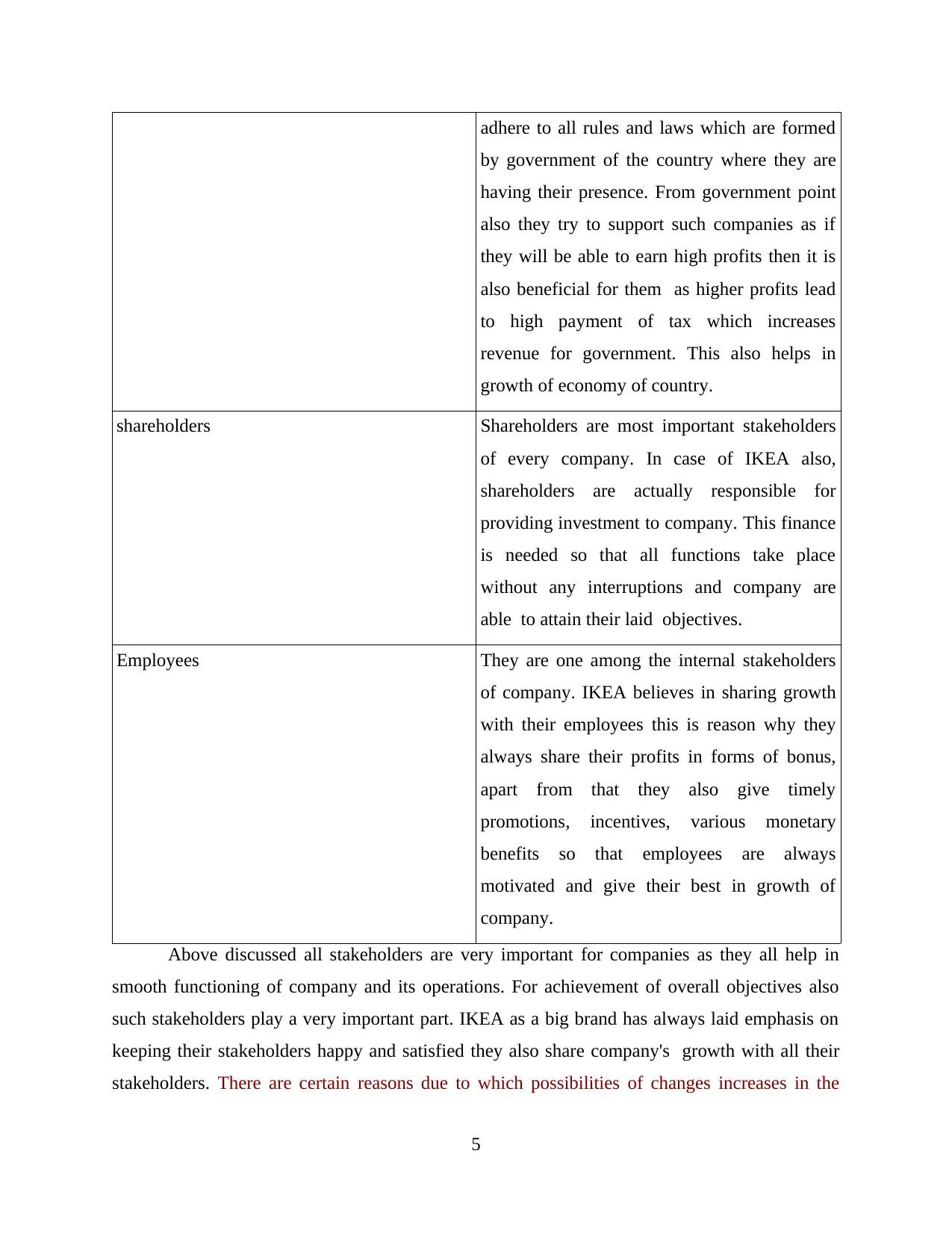
adhere to all rules and laws which are formed
by government of the country where they are
having their presence. From government point
also they try to support such companies as if
they will be able to earn high profits then it is
also beneficial for them as higher profits lead
to high payment of tax which increases
revenue for government. This also helps in
growth of economy of country.
shareholders Shareholders are most important stakeholders
of every company. In case of IKEA also,
shareholders are actually responsible for
providing investment to company. This finance
is needed so that all functions take place
without any interruptions and company are
able to attain their laid objectives.
Employees They are one among the internal stakeholders
of company. IKEA believes in sharing growth
with their employees this is reason why they
always share their profits in forms of bonus,
apart from that they also give timely
promotions, incentives, various monetary
benefits so that employees are always
motivated and give their best in growth of
company.
Above discussed all stakeholders are very important for companies as they all help in
smooth functioning of company and its operations. For achievement of overall objectives also
such stakeholders play a very important part. IKEA as a big brand has always laid emphasis on
keeping their stakeholders happy and satisfied they also share company's growth with all their
stakeholders. There are certain reasons due to which possibilities of changes increases in the
5
by government of the country where they are
having their presence. From government point
also they try to support such companies as if
they will be able to earn high profits then it is
also beneficial for them as higher profits lead
to high payment of tax which increases
revenue for government. This also helps in
growth of economy of country.
shareholders Shareholders are most important stakeholders
of every company. In case of IKEA also,
shareholders are actually responsible for
providing investment to company. This finance
is needed so that all functions take place
without any interruptions and company are
able to attain their laid objectives.
Employees They are one among the internal stakeholders
of company. IKEA believes in sharing growth
with their employees this is reason why they
always share their profits in forms of bonus,
apart from that they also give timely
promotions, incentives, various monetary
benefits so that employees are always
motivated and give their best in growth of
company.
Above discussed all stakeholders are very important for companies as they all help in
smooth functioning of company and its operations. For achievement of overall objectives also
such stakeholders play a very important part. IKEA as a big brand has always laid emphasis on
keeping their stakeholders happy and satisfied they also share company's growth with all their
stakeholders. There are certain reasons due to which possibilities of changes increases in the
5
Paraphrase This Document
Need a fresh take? Get an instant paraphrase of this document with our AI Paraphraser

organisation as such because of the conflicts in between the individual goals and conflict with
strategies for organisational changes due to which it becomes important for the organisation to
make changes in the working strategic objectives of the company. When personal conflicts arises
in relation to the interest of their employees, this disturbs the working of an organisation so in
order to make improvement in the performances of their employees and the working of
organisation, it is important for the company to make changes in their strategic objectives. In this
way, stakeholders impacts upon the working and strategic objectives of the company.
TASK 2
Assessment of internal environment and capabilities
SWOT analysis:
Strength Weakness
Ikea is having a reputation in the
market that they are dealing in furniture
which is of good quality and is
available at reasonable process
They posses a vast network of stores
which are ultra modern
They use integrated approach in their
manufacturing and supply chain
Ikea is having growing structure and
profit is rising each passing year.
Stores of Ikea are mostly located far
from the it which is sometimes
inconvenient for people to visit there
very frequently.
They take very high lead time in
planning for their new stores.
Ikea is having a standard portfolio of
products throughout all its stores
company has faced many issues and
controversies related to durability and
safety of furniture they are dealing in.
Opportunities Threats
There can be expansion done for
manufacturing of furniture at low cost
so that products can be offered at more
reasonable prices
with growing popularity of e-
commerce, such technology should be
There are entry barriers in new markets
which company is willing to enter.
Being in the furniture industry there are
so many law and regulation which they
have to adhere.
They face price based competition and
6
strategies for organisational changes due to which it becomes important for the organisation to
make changes in the working strategic objectives of the company. When personal conflicts arises
in relation to the interest of their employees, this disturbs the working of an organisation so in
order to make improvement in the performances of their employees and the working of
organisation, it is important for the company to make changes in their strategic objectives. In this
way, stakeholders impacts upon the working and strategic objectives of the company.
TASK 2
Assessment of internal environment and capabilities
SWOT analysis:
Strength Weakness
Ikea is having a reputation in the
market that they are dealing in furniture
which is of good quality and is
available at reasonable process
They posses a vast network of stores
which are ultra modern
They use integrated approach in their
manufacturing and supply chain
Ikea is having growing structure and
profit is rising each passing year.
Stores of Ikea are mostly located far
from the it which is sometimes
inconvenient for people to visit there
very frequently.
They take very high lead time in
planning for their new stores.
Ikea is having a standard portfolio of
products throughout all its stores
company has faced many issues and
controversies related to durability and
safety of furniture they are dealing in.
Opportunities Threats
There can be expansion done for
manufacturing of furniture at low cost
so that products can be offered at more
reasonable prices
with growing popularity of e-
commerce, such technology should be
There are entry barriers in new markets
which company is willing to enter.
Being in the furniture industry there are
so many law and regulation which they
have to adhere.
They face price based competition and
6

used by the company in promotion and
marketing of their products.
also there are short of diversification
strategies on part of company.
VRIO analysis: VRIO framework is used by companies to evaluate their weakness and
strength. This is a laid framework which is used by companies to do evaluation on four basic
aspects which includes value, rarity, inimitable and organization. Four resources of IKEA which
are human resource, global presence, technology and goodwill of the company is covered under
its main resources.
Valuable: Above discussed four resources are valuable for company in a way that human
resource IKEA will not able to execute its single function. The following are the main
resources of the company which are valuable to them as such technology of the company,
global presence, goodwill and personnel of the company which will help it is achieving
sustainable competitive advantage over their competitors. These resources are valuable as
thye help in some or other way in order to make an increment in the overall production,
growth and development of the organisation.
Rare: The following term considers those resources of the organisation which are rare
or scare to have. So among the resources of the company, the resources which are rare
are technology, goodwill and global presences as these are achieved after years of good
and effective working along with good brand image of company in the society and minds
of customers (Morton, Wilson and Cooke, 2015).
Imitable: The resources of IKEA which are considered as Imitable are goodwill and
technology as these are the main resources which are not possible for the company to
imitate easily at any cost. As such patents are done to secure technology, and goodwill is
nor made in any single period of time. It requires years of working so the following tow
resource of the company are considered as imitable.
Organization: The resources which could provide the company with value are goodwill,
technology with the help of which it will be possible for the company to achieve
competitive edge over their competitors for the betterment and growth of the
organisation.
However, the working of this organisation is good but in order to make improvement in
the overall position of the company it is important for the company to focus on improving their
7
marketing of their products.
also there are short of diversification
strategies on part of company.
VRIO analysis: VRIO framework is used by companies to evaluate their weakness and
strength. This is a laid framework which is used by companies to do evaluation on four basic
aspects which includes value, rarity, inimitable and organization. Four resources of IKEA which
are human resource, global presence, technology and goodwill of the company is covered under
its main resources.
Valuable: Above discussed four resources are valuable for company in a way that human
resource IKEA will not able to execute its single function. The following are the main
resources of the company which are valuable to them as such technology of the company,
global presence, goodwill and personnel of the company which will help it is achieving
sustainable competitive advantage over their competitors. These resources are valuable as
thye help in some or other way in order to make an increment in the overall production,
growth and development of the organisation.
Rare: The following term considers those resources of the organisation which are rare
or scare to have. So among the resources of the company, the resources which are rare
are technology, goodwill and global presences as these are achieved after years of good
and effective working along with good brand image of company in the society and minds
of customers (Morton, Wilson and Cooke, 2015).
Imitable: The resources of IKEA which are considered as Imitable are goodwill and
technology as these are the main resources which are not possible for the company to
imitate easily at any cost. As such patents are done to secure technology, and goodwill is
nor made in any single period of time. It requires years of working so the following tow
resource of the company are considered as imitable.
Organization: The resources which could provide the company with value are goodwill,
technology with the help of which it will be possible for the company to achieve
competitive edge over their competitors for the betterment and growth of the
organisation.
However, the working of this organisation is good but in order to make improvement in
the overall position of the company it is important for the company to focus on improving their
7
⊘ This is a preview!⊘
Do you want full access?
Subscribe today to unlock all pages.

Trusted by 1+ million students worldwide
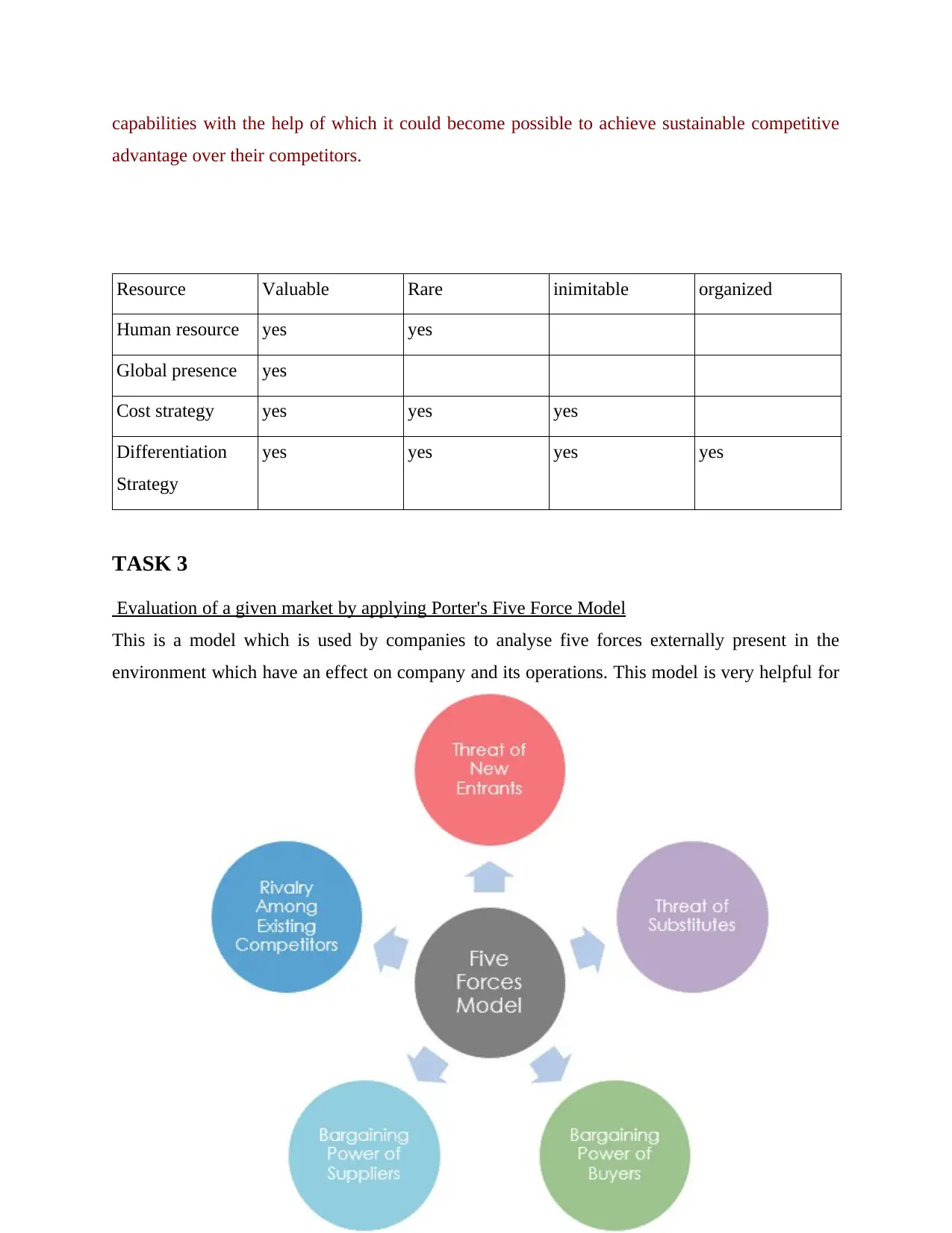
capabilities with the help of which it could become possible to achieve sustainable competitive
advantage over their competitors.
Resource Valuable Rare inimitable organized
Human resource yes yes
Global presence yes
Cost strategy yes yes yes
Differentiation
Strategy
yes yes yes yes
TASK 3
Evaluation of a given market by applying Porter's Five Force Model
This is a model which is used by companies to analyse five forces externally present in the
environment which have an effect on company and its operations. This model is very helpful for
8
advantage over their competitors.
Resource Valuable Rare inimitable organized
Human resource yes yes
Global presence yes
Cost strategy yes yes yes
Differentiation
Strategy
yes yes yes yes
TASK 3
Evaluation of a given market by applying Porter's Five Force Model
This is a model which is used by companies to analyse five forces externally present in the
environment which have an effect on company and its operations. This model is very helpful for
8
Paraphrase This Document
Need a fresh take? Get an instant paraphrase of this document with our AI Paraphraser
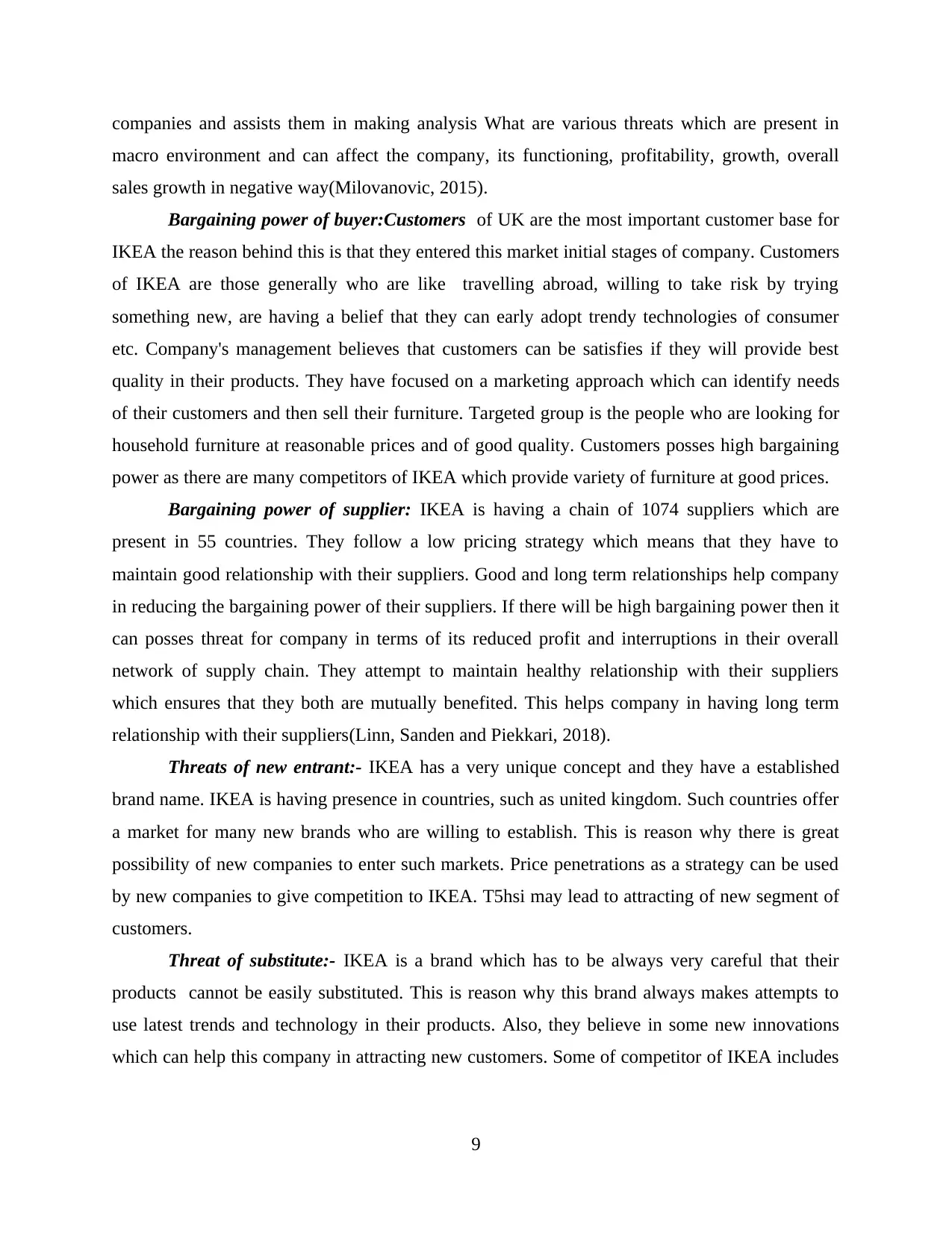
companies and assists them in making analysis What are various threats which are present in
macro environment and can affect the company, its functioning, profitability, growth, overall
sales growth in negative way(Milovanovic, 2015).
Bargaining power of buyer:Customers of UK are the most important customer base for
IKEA the reason behind this is that they entered this market initial stages of company. Customers
of IKEA are those generally who are like travelling abroad, willing to take risk by trying
something new, are having a belief that they can early adopt trendy technologies of consumer
etc. Company's management believes that customers can be satisfies if they will provide best
quality in their products. They have focused on a marketing approach which can identify needs
of their customers and then sell their furniture. Targeted group is the people who are looking for
household furniture at reasonable prices and of good quality. Customers posses high bargaining
power as there are many competitors of IKEA which provide variety of furniture at good prices.
Bargaining power of supplier: IKEA is having a chain of 1074 suppliers which are
present in 55 countries. They follow a low pricing strategy which means that they have to
maintain good relationship with their suppliers. Good and long term relationships help company
in reducing the bargaining power of their suppliers. If there will be high bargaining power then it
can posses threat for company in terms of its reduced profit and interruptions in their overall
network of supply chain. They attempt to maintain healthy relationship with their suppliers
which ensures that they both are mutually benefited. This helps company in having long term
relationship with their suppliers(Linn, Sanden and Piekkari, 2018).
Threats of new entrant:- IKEA has a very unique concept and they have a established
brand name. IKEA is having presence in countries, such as united kingdom. Such countries offer
a market for many new brands who are willing to establish. This is reason why there is great
possibility of new companies to enter such markets. Price penetrations as a strategy can be used
by new companies to give competition to IKEA. T5hsi may lead to attracting of new segment of
customers.
Threat of substitute:- IKEA is a brand which has to be always very careful that their
products cannot be easily substituted. This is reason why this brand always makes attempts to
use latest trends and technology in their products. Also, they believe in some new innovations
which can help this company in attracting new customers. Some of competitor of IKEA includes
9
macro environment and can affect the company, its functioning, profitability, growth, overall
sales growth in negative way(Milovanovic, 2015).
Bargaining power of buyer:Customers of UK are the most important customer base for
IKEA the reason behind this is that they entered this market initial stages of company. Customers
of IKEA are those generally who are like travelling abroad, willing to take risk by trying
something new, are having a belief that they can early adopt trendy technologies of consumer
etc. Company's management believes that customers can be satisfies if they will provide best
quality in their products. They have focused on a marketing approach which can identify needs
of their customers and then sell their furniture. Targeted group is the people who are looking for
household furniture at reasonable prices and of good quality. Customers posses high bargaining
power as there are many competitors of IKEA which provide variety of furniture at good prices.
Bargaining power of supplier: IKEA is having a chain of 1074 suppliers which are
present in 55 countries. They follow a low pricing strategy which means that they have to
maintain good relationship with their suppliers. Good and long term relationships help company
in reducing the bargaining power of their suppliers. If there will be high bargaining power then it
can posses threat for company in terms of its reduced profit and interruptions in their overall
network of supply chain. They attempt to maintain healthy relationship with their suppliers
which ensures that they both are mutually benefited. This helps company in having long term
relationship with their suppliers(Linn, Sanden and Piekkari, 2018).
Threats of new entrant:- IKEA has a very unique concept and they have a established
brand name. IKEA is having presence in countries, such as united kingdom. Such countries offer
a market for many new brands who are willing to establish. This is reason why there is great
possibility of new companies to enter such markets. Price penetrations as a strategy can be used
by new companies to give competition to IKEA. T5hsi may lead to attracting of new segment of
customers.
Threat of substitute:- IKEA is a brand which has to be always very careful that their
products cannot be easily substituted. This is reason why this brand always makes attempts to
use latest trends and technology in their products. Also, they believe in some new innovations
which can help this company in attracting new customers. Some of competitor of IKEA includes
9

Wal-mart, Office depot which are also providing low cost furniture, IKEA should make attempts
that their sales are not affected because of such brands(Lee, 2014).
Rivalry within market:- IKEA has always made efforts to attain a competitive edge in
market. They are functioning in a extremely competitive environment where there are many
companies who are offering wide range of variety furniture and at adequate quality. IKEA as a
brand has been very successful in entering those markets which are very competitive such as
markets of japan and china. Positioning is a strategy which has been adopted by IKEA since its
initial stages, as they always laid emphasis on fulfilment of all expectations of their target
customers which offered them a distinct position in market.
Above mentioned were some of the aspects on which porter's five force model is based on and
this has a effect on IKEA.
In order to make reduction in the bargaining power of their suppliersand customers, it is
important for the company to make use of easliy available reosurces and provide their customers
with differentiated products and services. These components will also impact upon the
profitability of the company as in case customers are able to influence the prices of their
company than this will make reduction in the prices and also the profits of the company. So the
profitability level is impacted. In this way, the different components of the model impacts upon
the profitablility level of the company.
Ans-off's growth vector matrix:-
It is a strategic management tool which company uses to plan their future development
and growth strategies. Ansoff matrix basically consists of four different strategies which is used
to support in overall functioning of a business(Lee and Smith, 201). IKEA has also used this
model to analyse four strategies and then according to that select the most appropriate strategy
which can be adopted by the company. Below four strategies from point of IKEA has been
discussed:
10
that their sales are not affected because of such brands(Lee, 2014).
Rivalry within market:- IKEA has always made efforts to attain a competitive edge in
market. They are functioning in a extremely competitive environment where there are many
companies who are offering wide range of variety furniture and at adequate quality. IKEA as a
brand has been very successful in entering those markets which are very competitive such as
markets of japan and china. Positioning is a strategy which has been adopted by IKEA since its
initial stages, as they always laid emphasis on fulfilment of all expectations of their target
customers which offered them a distinct position in market.
Above mentioned were some of the aspects on which porter's five force model is based on and
this has a effect on IKEA.
In order to make reduction in the bargaining power of their suppliersand customers, it is
important for the company to make use of easliy available reosurces and provide their customers
with differentiated products and services. These components will also impact upon the
profitability of the company as in case customers are able to influence the prices of their
company than this will make reduction in the prices and also the profits of the company. So the
profitability level is impacted. In this way, the different components of the model impacts upon
the profitablility level of the company.
Ans-off's growth vector matrix:-
It is a strategic management tool which company uses to plan their future development
and growth strategies. Ansoff matrix basically consists of four different strategies which is used
to support in overall functioning of a business(Lee and Smith, 201). IKEA has also used this
model to analyse four strategies and then according to that select the most appropriate strategy
which can be adopted by the company. Below four strategies from point of IKEA has been
discussed:
10
⊘ This is a preview!⊘
Do you want full access?
Subscribe today to unlock all pages.

Trusted by 1+ million students worldwide
1 out of 18
Related Documents
Your All-in-One AI-Powered Toolkit for Academic Success.
+13062052269
info@desklib.com
Available 24*7 on WhatsApp / Email
![[object Object]](/_next/static/media/star-bottom.7253800d.svg)
Unlock your academic potential
Copyright © 2020–2025 A2Z Services. All Rights Reserved. Developed and managed by ZUCOL.





